Influence of Primer Layer Configuration and Substrate Heterogeneity on the Overall Interfacial Performance of Waterborne Acrylic Coatings on Flattened Bamboo
Abstract
1. Introduction
2. Materials and Methods
2.1. Materials
2.2. Coating Procedures
2.3. Measurements and Characterization
2.3.1. Surface Roughness Analysis
2.3.2. Wettability and Contact Angle Measurement
2.3.3. Coating Adhesion and Hardness Evaluation
2.3.4. Surface Chemistry and Microstructure Characterization
2.3.5. Abrasion Resistance Test
2.4. Statistical Analysis
3. Results and Discussion
3.1. Surface Morphology and Chemical Composition Characteristics
3.2. Surface Roughness and Wettability Analysis
3.3. Coating Performance and Influencing Factors
3.4. Coating Adhesion Characteristics Revealed by SEM
4. Conclusions
- (1)
- Parenchyma-rich regions (high O/C ratio, rough) promote strong adhesion and superior abrasion resistance, whereas fiber-dominated regions (low O/C ratio, smooth) constitute inherent weak points for interfacial failure.
- (2)
- Multilayer priming enhances film integrity and wear stability in the porous, high-polarity inner layer but has limited efficacy on the dense, low-polarity outer layer. The higher pencil hardness observed on outer-layer surfaces is mainly attributed to their underlying fiber-dense composition.
- (3)
- SEM analysis confirms that robust adhesion relies on primer infiltration and mechanical interlocking within parenchyma lumina, a mechanism impeded by compact fiber bundles.
Author Contributions
Funding
Institutional Review Board Statement
Informed Consent Statement
Data Availability Statement
Acknowledgments
Conflicts of Interest
References
- Yuan, T.; Wang, X.; Liu, X.; Lou, Z.; Mao, S.; Li, Y. Bamboo Flattening Technology Ebables Efficient and Value-Added Utilization of Bamboo in the Manufacture of Furniture and Engineered Composites. Compos. Part B Eng. 2022, 242, 110097. [Google Scholar] [CrossRef]
- Ma, L.; Zhao, Y.; Zhang, T.; Yuan, T.; Wang, X.; Li, Y. Functionalized Flattened Bamboo Board: In-Situ Immersion Assembly of Flame-Retardant, Waterproof and Anti-Mold Composite Coatings. Int. J. Biol. Macromol. 2024, 278, 134881. [Google Scholar] [CrossRef] [PubMed]
- Zhao, Y.; Xie, X.; Wang, X.; Mao, S.; Li, Y. In Situ Retention of Lignin-Rich Bamboo Green Effectively Improves the Surface Properties of Flattened Bamboo. Int. J. Biol. Macromol. 2024, 264, 130411. [Google Scholar] [CrossRef] [PubMed]
- Mucci, V.L.; Hormaiztegui, M.E.V.; Amalvy, J.I.; Aranguren, M.I. Formulation, Structure and Properties of Waterborne Polyurethane Coatings: A Brief Review. J. Adhes. Sci. Technol. 2024, 38, 489–516. [Google Scholar] [CrossRef]
- Wang, J.; Zhou, Y.; Li, J.; Feng, Y.; Zhang, J.; Yu, H.; Zhuang, X. Improved Wettability and Dimensional Stability of Bamboo Timber by Coating Graphene/Silica Composites. Int. J. Polym. Sci. 2021, 2021, 1–10. [Google Scholar] [CrossRef]
- Duan, S.; Li, M.; Xie, D.; Xu, R.; Wang, S.; Wang, C.; Zhan, H. Silicon Deposition and Phytolith Morphological Variation in Culm Sheaths of Dendrocalamus brandisii at Different Growth Stages. Plants 2025, 14, 841. [Google Scholar] [CrossRef]
- Choi, Y.-H.; Kim, B.; Sim, J.-Y.; Kim, K.-J.; Park, S.-Y. Coating Performance Enhancement of Moso Bamboo (Phyllostachys edulis) via Hand Sanding: Effects of Surface Dewaxing and Fibrillation. BioRes 2025, 20, 9625–9640. [Google Scholar] [CrossRef]
- Zhao, Y.; Ma, L.; Xie, X.; Yuan, T.; Yu, X.; Chen, L.; Li, Y. Mechanisms of Two Types of Flattening Treatments on the Bonding Characteristics of Bamboo and the Effect of Laminate Design on Flexural Properties. Constr. Build. Mater. 2023, 408, 133673. [Google Scholar] [CrossRef]
- Rajan, R.; Zulkifli, R.; Mat Tahir, M.F.; Ude, A.U. Surface Wettability of Gigantochloa scortechinii Bamboo Fibers: Effects of Heat Treatment and Epoxy Coating in Seawater. J. Nat. Fibers 2024, 21, 2400532. [Google Scholar] [CrossRef]
- Alcantara, B.J.; Ilasin, M.D.; Gilos, M.N.R.; Wada, M.; Vasquez, M.R. Enhancing Polyvinyl Acetate Adhesion via Atmospheric Pressure Plasma Treatment of Bamboo (Bambusa spinosa Roxb.). Adv. Bamboo Sci. 2025, 13, 100200. [Google Scholar] [CrossRef]
- Liu, C.; Xu, W. Effect of Coating Process on Properties of Two-Component Waterborne Polyurethane Coatings for Wood. Coatings 2022, 12, 1857. [Google Scholar] [CrossRef]
- Zhang, Y.; Yu, Y.; Lu, Y.; Yu, W.; Wang, S. Effects of Heat Treatment on Surface Physicochemical Properties and Sorption Behavior of Bamboo (Phyllostachys edulis). Constr. Build. Mater. 2021, 282, 122683. [Google Scholar] [CrossRef]
- Wang, Q.; Han, H.; Lou, Z.; Han, X.; Wang, X.; Li, Y. Surface Property Enhancement of Bamboo by Inorganic Materials Coating with Extended Functional Applications. Compos. Part A Appl. Sci. Manuf. 2022, 155, 106848. [Google Scholar] [CrossRef]
- Chen, H.; Zhang, Y.; Yang, X.; Ji, H.; Zhong, T.; Wang, G. A Comparative Study of the Microstructure and Water Permeability between Flattened Bamboo and Bamboo Culm. J. Wood Sci. 2019, 65, 64. [Google Scholar] [CrossRef]
- Zheng, Z.; Yan, N.; Lou, Z.; Jiang, X.; Zhang, X.; Chen, S.; Xu, R.; Liu, C.; Xu, L. Modification and Application of Bamboo-Based Materials: A Review—Part I: Modification Methods and Mechanisms. Forests 2023, 14, 2219. [Google Scholar] [CrossRef]
- Xie, X.; Yuan, T.; Yao, Y.; Li, G.; Li, Y.; Wang, X. Phytic Acid-Based Hybrid Complexes for Improving the Interfacial Property and Mildew-Resistance of Heat-Treated Bamboo. Colloids Surf. A Physicochem. Eng. Asp. 2023, 659, 130749. [Google Scholar] [CrossRef]
- Zhou, X.; Guo, H.; Wang, S.; Yu, L.; Li, H.; Yang, Z. Performance Testing of Modified Waterborne Polyurethane Coating Applied on Laminated Bamboo. Bioresources 2022, 17, 6191–6202. [Google Scholar] [CrossRef]
- Chen, J.; Zhao, Y.; Yuan, S.; Zhang, J.; Li, Q.; Wang, H. Drying Process of Waterborne Paint Film on Bamboo Laminated Lumber for Furniture. Polymers 2023, 15, 1288. [Google Scholar] [CrossRef]
- GB/T 4893.4-2023; Physical and Chemical Property Test of Furniture Surface Paint Film Part 4: Adhesion Cross-Cutting Method. Standardization Administration of the People’s Republic of China: Beijing, China, 2023.
- GB/T 6739-2022; Determination of Paint Film Hardness by the Pencil Method for Color Paints and Varnishes. Standardization Administration of the People’s Republic of China: Beijing, China, 2022.
- GB/T 4893.8-2023; Physical and Chemical Property Test of Furniture Surface Paint Film Part 8: Determination of Resistance to Abrasion. Standardization Administration of the People’s Republic of China: Beijing, China, 2023.
- Chen, H.; Wu, J.; Shi, J.; Zhang, W.; Wang, H. Effect of Alkali Treatment on Microstructure and Thermal Stability of Parenchyma Cell Compared with Bamboo Fiber. Ind. Crops Prod. 2021, 164, 113380. [Google Scholar] [CrossRef]
- Zhang, W.; Tian, G.; Polle, A.; Janz, D.; Euring, D.; Yue, X.; Zhao, H.; Fei, B.; Jiang, Z. Comparative Characterization of Ethanol Organosolv Lignin Polymer from Bamboo Green, Timber and Yellow. Wood Sci. Technol. 2018, 52, 1331–1341. [Google Scholar] [CrossRef]
- Rocky, B.P.; Thompson, A.J. Analyses of the Chemical Compositions and Structures of Four Bamboo Species and Their Natural Fibers by Infrared, Laser, and X-Ray Spectroscopies. Fibers Polym. 2021, 22, 916–927. [Google Scholar] [CrossRef]
- Li, J.; Lian, C.; Wu, J.; Zhong, T.; Zou, Y.; Chen, H. Morphology, Chemical Composition and Thermal Stability of Bamboo Parenchyma Cells and Fibers Isolated by Different Methods. Cellulose 2023, 30, 2007–2021. [Google Scholar] [CrossRef]
- Mitani, A.; Kamperidou, V.; Terzopoulou, P. Surface Treatment of Oak Wood with Silica Dioxide Nanoparticles and Paraloid B72. Forests 2024, 15, 1842. [Google Scholar] [CrossRef]
- Jian, Y.; Xu, T.; Hess, D.W.; Tang, W.; Chai, X.; Zhang, L.; Xu, K.; Guo, Z.; Wan, H.; Xie, L. Efficient Synthesis of Durable Superhydrophobic SiO2@PFDMS Coatings on Bamboo by Liquid Deposition. Ind. Crops Prod. 2024, 219, 119078. [Google Scholar] [CrossRef]
- Chang, H.; Tu, K.; Wang, X.; Liu, J. Facile Preparation of Stable Superhydrophobic Coatings on Wood Surfaces Using Silica-Polymer Nanocomposites. Bioresources 2015, 10, 2585–2596. [Google Scholar] [CrossRef]
- Yu, Q.; Pan, X.; Yang, Z.; Zhang, L.; Cao, J. Effects of the Surface Roughness of Six Wood Species for Furniture Production on the Wettability and Bonding Quality of Coating. Forests 2023, 14, 996. [Google Scholar] [CrossRef]
- Du, J.; Yang, K.-L.; Yuan, Z.-Q.; Li, X.-Y.; Liu, S.-J.; Li, C.-C.; Meng, S. Preparation of a Robust and Stable Superhydrophobic Coating with Self-Cleaning and Mold Resistance Properties on Natural Bamboo Substrate. Constr. Build. Mater. 2024, 411, 134454. [Google Scholar] [CrossRef]
- He, L.; Chen, L.; Shao, H.; Qi, J.; Jiang, Y.; Xiao, H.; Chen, Y.; Huang, X.; Xie, J. Microstructure and Physicochemical Properties of the Anisotropic Moso Bamboo (Phyllostachys pubescens) Surface. Eur. J. Wood Prod. 2022, 80, 277–288. [Google Scholar] [CrossRef]
- Wu, J.; Zhong, T.; Zou, Y.; Li, J.; Zhao, W.; Chen, H. Microstructure, Chemical Composition and Thermal Stability of Alkali-Treated Bamboo Fibers and Parenchyma Cells: Effects of Treatment Time and Temperature. Cellulose 2023, 30, 1911–1925. [Google Scholar] [CrossRef]
- Lu, K.-T. Effects of Hydrogen Peroxide Treatment on the Surface Properties and Adhesion of Ma Bamboo (Dendrocalamus latiflorus). J. Wood Sci. 2006, 52, 173–178. [Google Scholar] [CrossRef]
- Xu, J.; Liu, R.; Wu, H.; Qiu, H.; Yu, Y.; Long, L. Coating Performance of Water-Based Polyurethane-Acrylate Coating on Bamboo/Bamboo Scrimber Substrates. Adv. Polym. Technol. 2019, 2019, 1–8. [Google Scholar] [CrossRef]
- Mariappan, T.; Kamble, A.; Naik, S.M. An Investigation of Primer Adhesion and Topcoat Compatibility on the Waterborne Intumescent Coating to Structural Steel. Prog. Org. Coat. 2019, 131, 371–377. [Google Scholar] [CrossRef]
- Cicek, H.; Akar, O.C.; Efeoglu, I. Structure and Adhesion Properties of TiNi/MoS2 Coatings. Ceram. Int. 2021, 47, 14033–14040. [Google Scholar] [CrossRef]
- Chen, L.; Lian, C.; Chen, M.; Wu, Z. Effects of Microstructure and Chemical Composition on the Visual Characteristics of Flattened Bamboo Board. Forests 2023, 14, 2220. [Google Scholar] [CrossRef]
- Xu, J.; Liu, R.; Wu, H.; Qiu, H.; Yu, Y.; Long, L.; Ni, Y. A Comparison of the Performance of Two Kinds of Waterborne Coatings on Bamboo and Bamboo Scrimber. Coatings 2019, 9, 161. [Google Scholar] [CrossRef]
- Hora, G. Improving Wet Adhesion of Water-Borne Acrylic Dispersion on Wood by Bond Activation. Surf. Coat. Int. Part B 2004, 87, 175–179. [Google Scholar] [CrossRef]
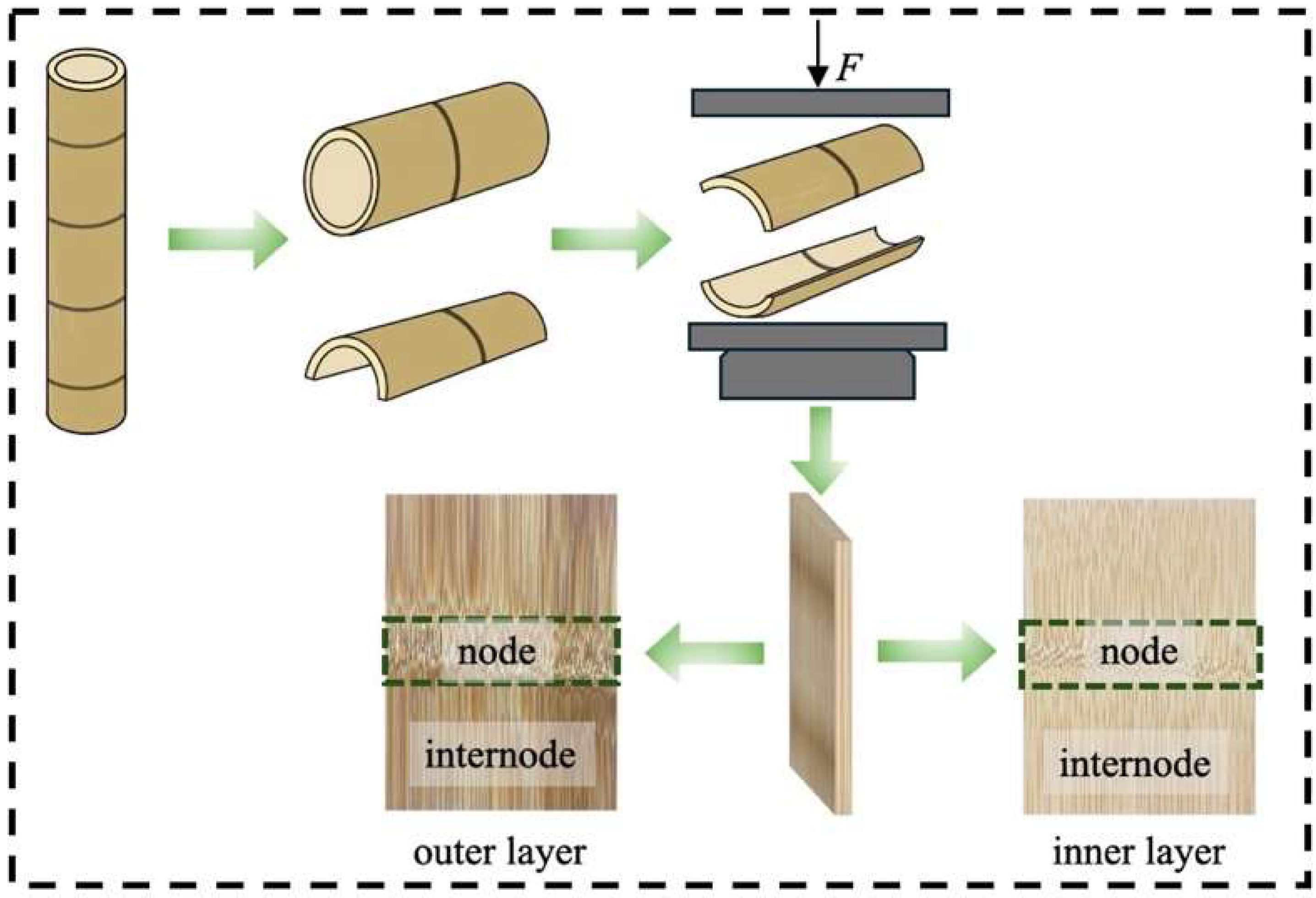

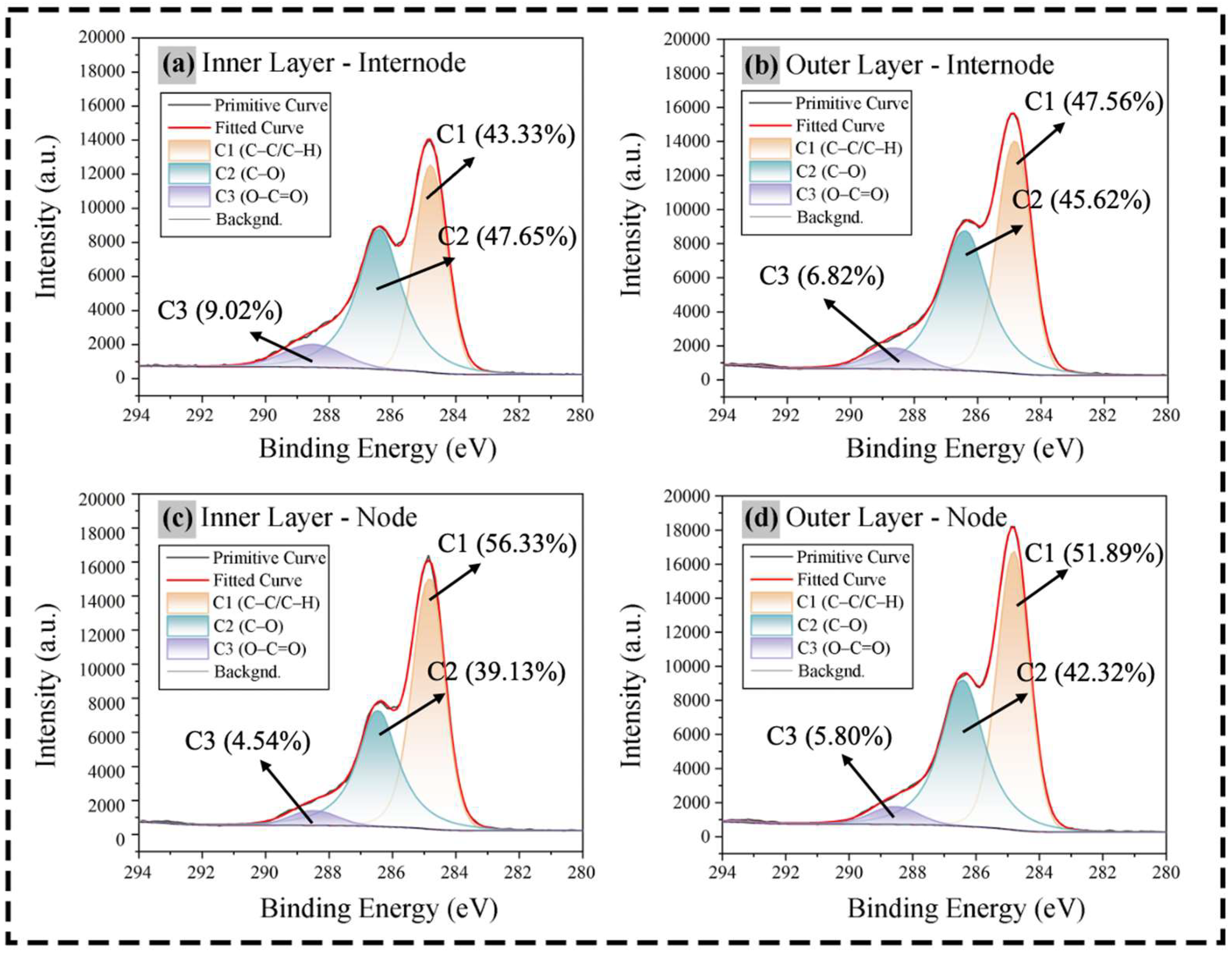

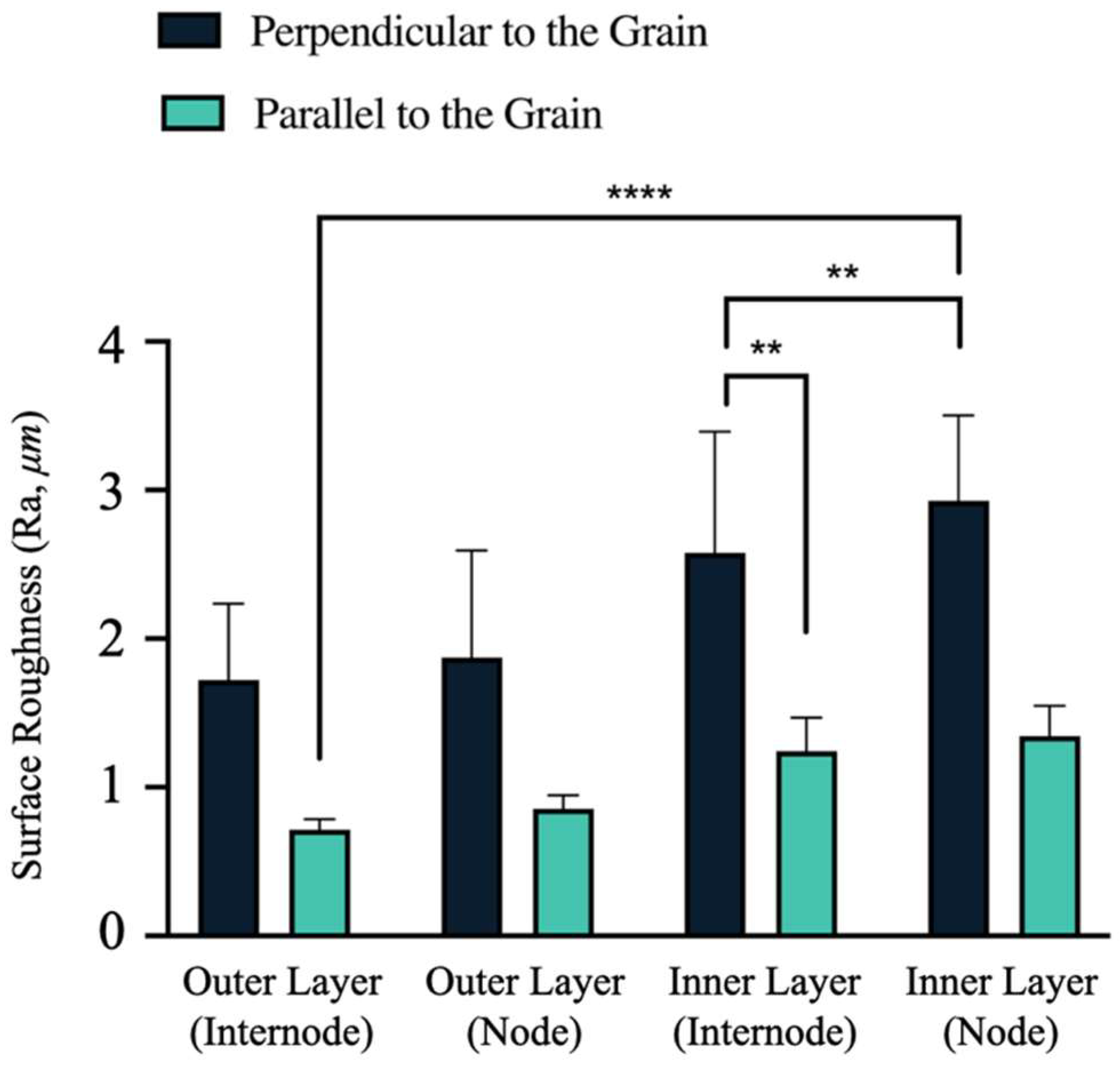
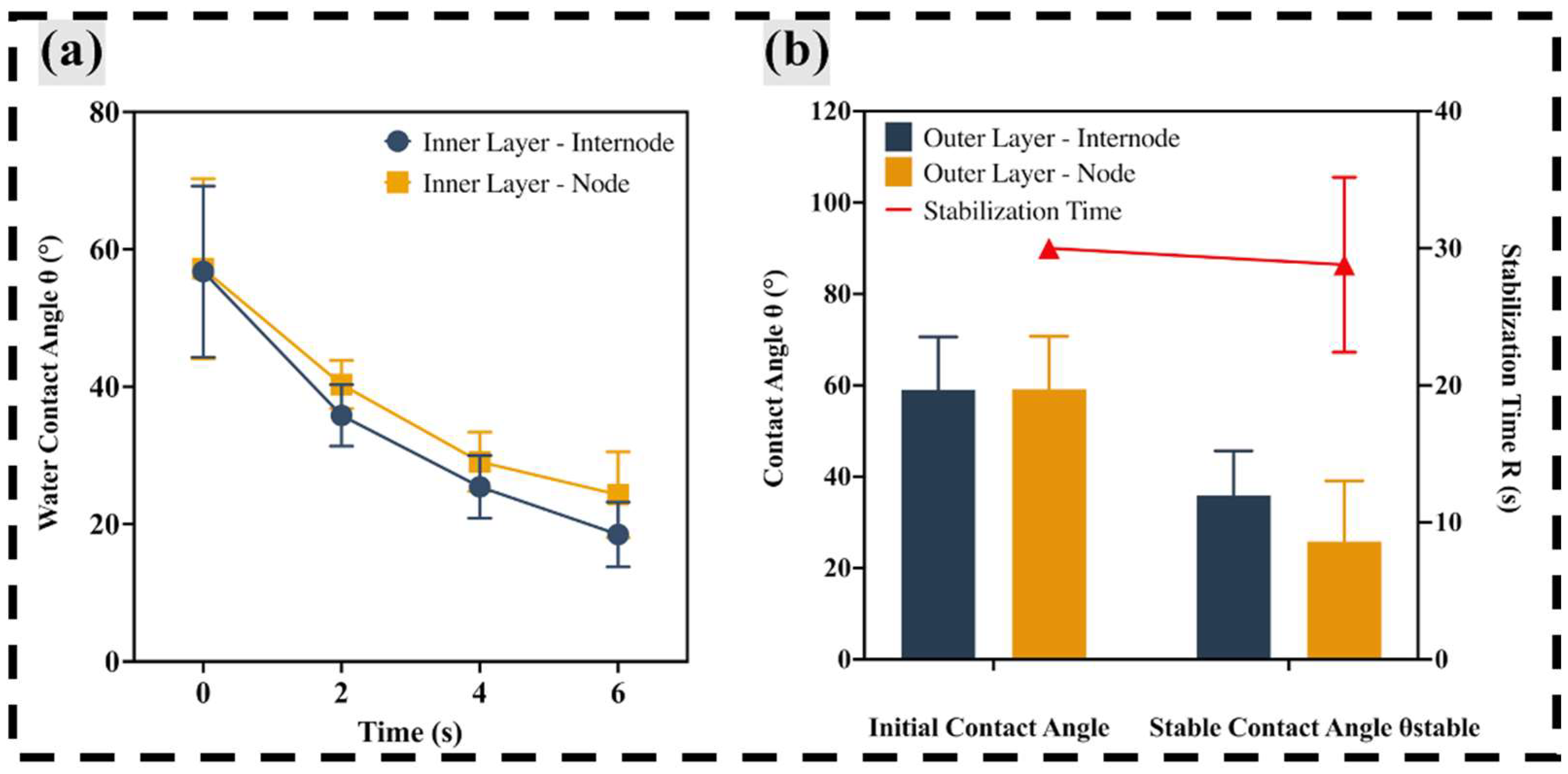


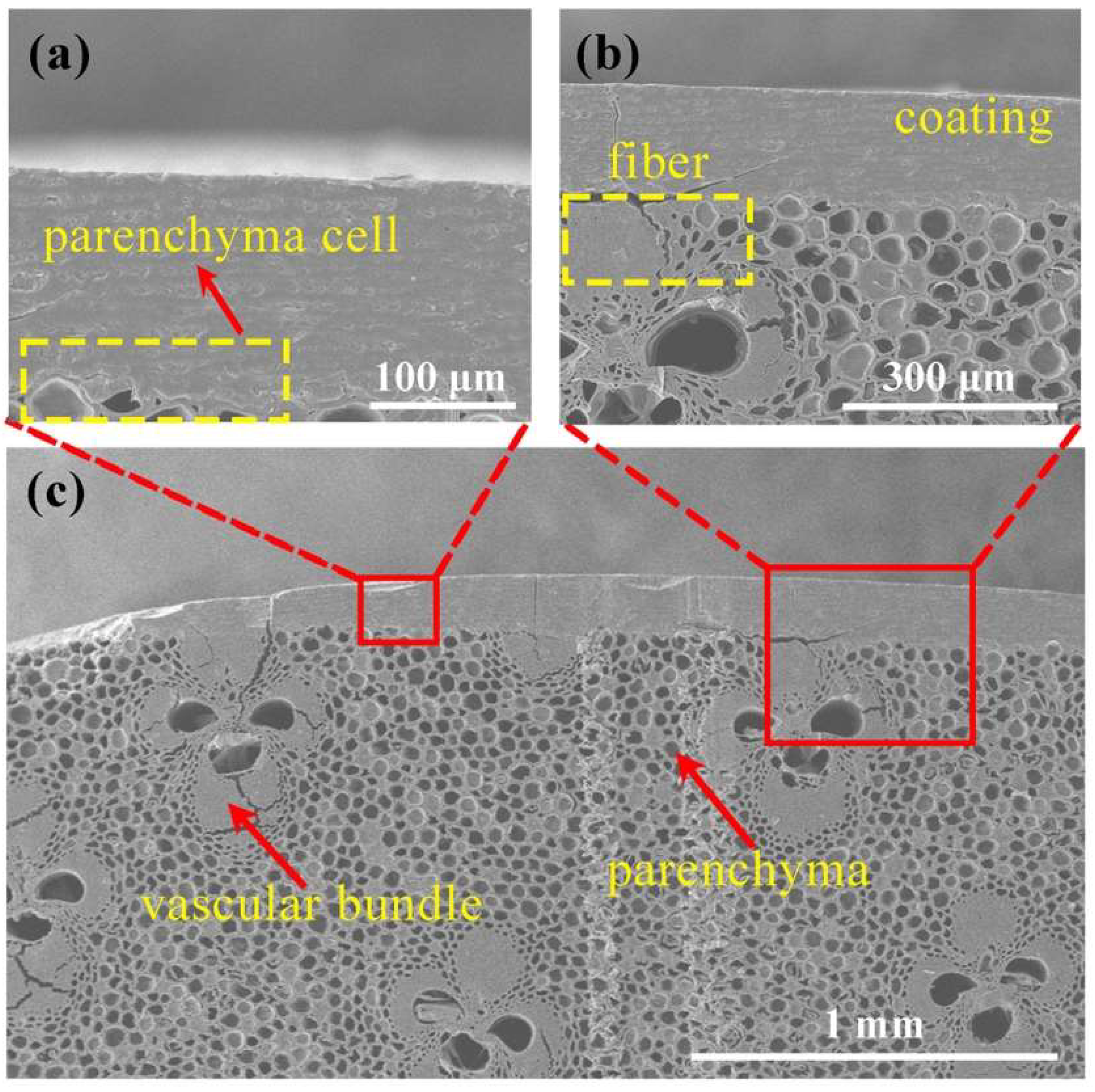
| Coating | Product Code | Resin Type | Solids Content (wt %) | Density (g cm−3) |
|---|---|---|---|---|
| Primer | WB-FWZ4301 | Waterborne one-component styrene–acrylic clear primer | 30–32 | 1.01–1.05 |
| Topcoat | WB-ZW51248 | Waterborne one-component acrylic copolymer clear topcoat | 31–33 | 1.02–1.08 |
| Sample | O/C | Percentage of C 1s Components (%) | Percentage of O 1s Components (%) | Atomic % of Si 2p | ||||
|---|---|---|---|---|---|---|---|---|
| C1 | C2 | C3 | O1 | O2 | O3 | |||
| inner layer–internode | 0.296 | 43.33 | 47.65 | 9.02 | 12.95 | 78.83 | 8.22 | 2.17 |
| outer layer–internode | 0.273 | 47.56 | 45.62 | 6.82 | 9.13 | 79.24 | 11.63 | 0.96 |
| inner layer–node | 0.273 | 56.33 | 39.13 | 4.54 | 16.18 | 57.74 | 25.08 | 1.75 |
| outer layer–node | 0.262 | 51.89 | 42.32 | 5.80 | 14.49 | 71.94 | 13.57 | 1.38 |
| Coating Process | Layer Type | Position | Adhesion | Hardness |
|---|---|---|---|---|
| 1P1T | inner layer | internode | 1 | B |
| 1P1T | inner layer | node | 2 | 2B |
| 1P1T | outer layer | internode | 1 | HB |
| 1P1T | outer layer | node | 1 | HB |
| 2P1T | inner layer | internode | 1 | B |
| 2P1T | inner layer | node | 2 | B |
| 2P1T | outer layer | internode | 1 | HB |
| 2P1T | outer layer | node | 1 | B |
| 3P1T | inner layer | internode | 0 | B |
| 3P1T | inner layer | node | 1 | B |
| 3P1T | outer layer | internode | 1 | HB |
| 3P1T | outer layer | node | 1 | B |
Disclaimer/Publisher’s Note: The statements, opinions and data contained in all publications are solely those of the individual author(s) and contributor(s) and not of MDPI and/or the editor(s). MDPI and/or the editor(s) disclaim responsibility for any injury to people or property resulting from any ideas, methods, instructions or products referred to in the content. |
© 2025 by the authors. Licensee MDPI, Basel, Switzerland. This article is an open access article distributed under the terms and conditions of the Creative Commons Attribution (CC BY) license (https://creativecommons.org/licenses/by/4.0/).
Share and Cite
Yu, Y.; Chen, H.; Wu, S.; Xu, W. Influence of Primer Layer Configuration and Substrate Heterogeneity on the Overall Interfacial Performance of Waterborne Acrylic Coatings on Flattened Bamboo. Coatings 2025, 15, 1307. https://doi.org/10.3390/coatings15111307
Yu Y, Chen H, Wu S, Xu W. Influence of Primer Layer Configuration and Substrate Heterogeneity on the Overall Interfacial Performance of Waterborne Acrylic Coatings on Flattened Bamboo. Coatings. 2025; 15(11):1307. https://doi.org/10.3390/coatings15111307
Chicago/Turabian StyleYu, Yingyue, Hong Chen, Shuangshuang Wu, and Wei Xu. 2025. "Influence of Primer Layer Configuration and Substrate Heterogeneity on the Overall Interfacial Performance of Waterborne Acrylic Coatings on Flattened Bamboo" Coatings 15, no. 11: 1307. https://doi.org/10.3390/coatings15111307
APA StyleYu, Y., Chen, H., Wu, S., & Xu, W. (2025). Influence of Primer Layer Configuration and Substrate Heterogeneity on the Overall Interfacial Performance of Waterborne Acrylic Coatings on Flattened Bamboo. Coatings, 15(11), 1307. https://doi.org/10.3390/coatings15111307






